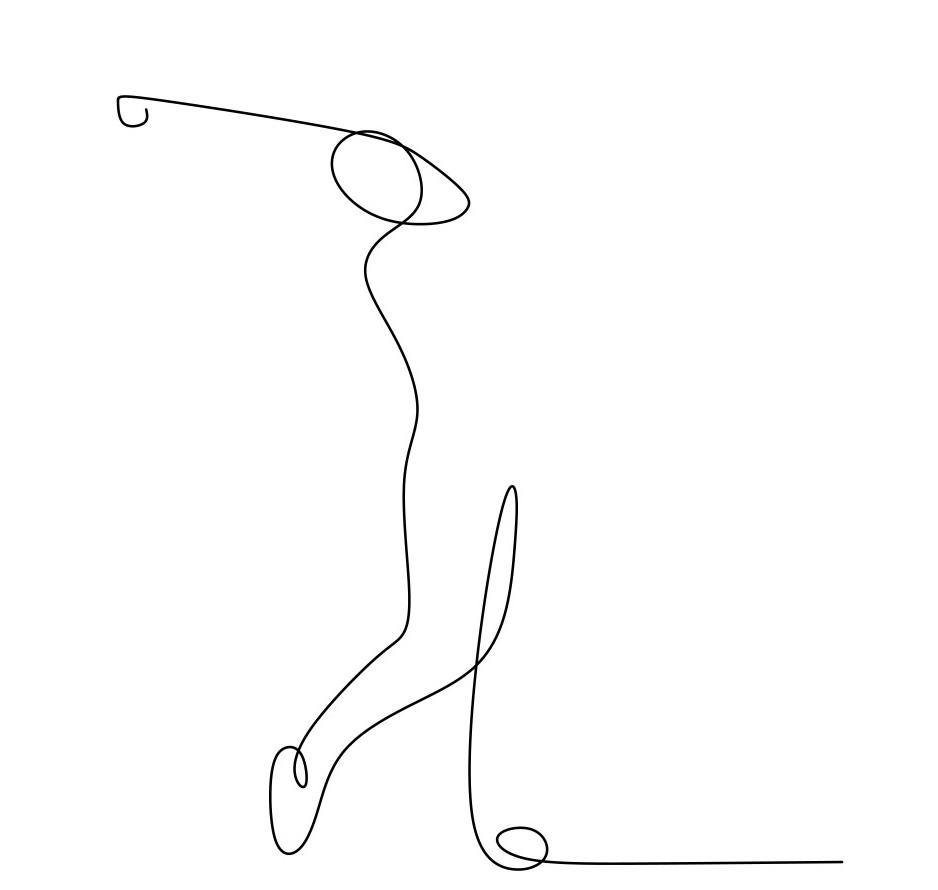As anyone who has read my article here will know, I like all things minimal, especially in golf. This is possibly a bit strange for someone who gets through as many iron sets as I do, but it makes sense (at least to me!) Even though I enjoy playing with and testing all sorts of clubs, I almost never have a full 14 in the bag. Currently, I have 11 in my main bag (driver, hybrid, 5-pw, 52, 56, putter if you are interested) and often as few as 5 or 6 when I go out for a few holes. So this is a minimalist bag but what is a minimalist golf swing?
There are different reasons for this. I generally carry, so lighter is better. I also don’t really play in competitions (at least not medal) anymore, so not having exactly the right club isn’t a problem. And lastly, but not least, I find fewer clubs free up my mind. Whilst many will argue that it is good to have as many options as possible in the bag (and more power to them) I find simpler works better for me. Long tee shot needed? Driver. Need to hit the fairway and get it in play? Hybrid.
Given that I have been playing like this for most of my recent golfing career, it is a bit strange that I haven’t ever really applied the same logic to the swing. Or have I?
What is a Minimalist Golf Swing?
I try not to tinker with my swing too much any more (at least compared to my clubs!) but I have recently realised that my grip has become very weak and might be responsible for some of the weak floaty shots I see now and again. While I was trying out a slightly stronger grip (at home, not yet on the course) I started thinking if there was anything else that might need a bit of work in my swing.
Now, my swing is far from perfect and a good coach would probably have a field day taking it apart and fixing it. But it is, I realised, both relatively solid and quite simple. Although I don’t like the idea of “one plane” swing theory simply because I don’t think it means what people think it means, my swing, as a friend recently pointed out, just goes back and then down and through again. No crazy movements, nothing too funky. Whilst you can play amazing golf with all sorts of moves in the swing -yes, Jim Furyk, I am talking to you!-, I was wondering if my move would be classified as minimalist and also what other options there are out there for those looking for a minimalist swing.
The Crazy World of Minimalist Golf.
Well, google (or bing/yahoo/duckduckgo) is my friend and I decided to plunge down the rabbit hole of some of the minimalist swings out there. And for something that is supposed to make life simpler, there are some pretty strange ways to go about it!
It seems that minimalist also rhymes with unique as far as swings go. So here is a run down of some of the approaches that you can find if you are looking to become a minimalist golfer.
The Minimalist Golf Swing System (MGSS)
The first one on my list is actually one I have come across before (and, in all honesty, I have probably seen most of the different swing “methods” being touted online at some point or another.) This one is the baby of Kiran Kanwar who, according to the MGSS site, was the 1983 All India Ladies’ Open Amateur Golf Champion as well as an LPGA qualified instructor and expert in biomechanics.
As is the case for virtually any swing system you care to mention, this one will have you hitting the ball further and straighter with less stress on the body, especially the back. So much for the theory, but what is the swing all about? Well, rather than try to explain it completely, here is a video that shows Kiran Kanwar teaching then hitting some balls.
Now, I am not a golf instructor, have never played one on TV and would be very hesitant to give anyone swing advice outside of the most obvious things. However, this is completely different to what might be considered a classical golf swing. That certainly doesn’t make it bad (just ask Bryson Dechambeau, and more on him later) but trying this method will certainly send you down a path that is, let’s say, less traditional.
The basic idea seems to be:
- Taking the club away inside after turning the body closed.
- Tilting the body at a particular angle
Again, I hate to judge this because I really am not a coach, but that initial tilt/turn away really does look unusual. It seems like there might be easier ways to get to a consistant, back friendly strike. But full admission, I haven’t tried this so it might just be the next best thing.
You can find out all about it here
Stack and Tilt
Stack and tilt seems to have fallen out of the public eye over the last couple of years, but it was very prominent at all levels of the game a few years ago and two of the arguments that were put forward were the simple nature of the swing and the body-friendly, solid-striking shots that it produced.
Firstly, a word of warning. Stack and tilt is right up there with “should beginners play blades” as a controversial topic in the golf world. If you really want to see an internet forum thread go downhill fast, try posting some sort of combination of blades/beginner/stack and tilt. Probably best to put your hard hat on first though!
Stack and tilt as a system is certainly more developed and well-known that the minimalist golf system mentioned above. There have been tour players who were playing with a stack and tilt swing and many teaching professionals use this as their preferred teaching method. So what is it exactly?
The origins of the system come from two well-know instructors, Mike Bennett and Andy Plummer. They insist (rightly, in my opinion) on their instruction/finding a qualified instructor rather than just trying to piece an S and T swing together from online stuff, so please don’t take this as an instruction article! However, there are some fairly well-known pieces of the puzzle that will at least give you some of the basics to try.
Some Stack and Tilt keys
- Keep the weight on the left side (if you are right-handed). There isn’t any sway onto the back foot. The weight should remain more forward throughout the swing.
- The left shoulder should move down rather than inwards.
- The hands stay inside, not out or up.
This is really a very brief overview, but might give you an idea. The real key is the wight moving forward throughout the swing to find a consistant low spot and strike.
If you want to find out more about Stack and Tilt, here is the website:
Moe Norman
There is a quote from Tiger Woods about the golf swing. It goes something like this:
“The only two people who owned their golf swing were Ben Hogan and Moe Norman.”
This probably tells you all you need to know about just how good a ball striker Moe Norman was. He is relatively unknown to the average golfer for a host of reasons, not many of which are really to do with how well he played the game. One thing that absolutely everyone who has seen him hit balls will say is this: he was perhaps the most consistent striker of a golf ball you will ever see. Many of the bits and pieces that are associated with him have come back into the spotlight through Bryson Dechambeau, particularly the oversize grips and the idea of a “one plane swing” (whatever that really means.)
Perhaps the reason why those looking for a minimalist golf swing are drawn to Moe is the swing he showed in his later years. Video of a younger Moe is quite hard to find but having seen a few clips, his swing was fairly classic (and looked great.) The more common videos of Moe are from his later years and this is what a lot of people are drawn to because it is a very simple, repeatable swing. He has his arms straight, is quite upright, turns back about halfway and then just turns back through.
In my opinion, this is a nice way to hit consistent golf shots but is also, at least when i tried, a good way to hi it fairly short. Depending on your circumstances, this might not be a problem, but it there is one thing guaranteed to kill off any swing to the golfing public, it is losing distance.
If you are curious about Moe, his legacy lives on through Robert Graves and his academy which you can find here. There is a strong emphasis on the virtues of single plane, so if that is your thing, you will enjoy it.
Bryson Dechambeau: Single Length Minimalism
A huge amount has been written about Bryson since he came onto the scene and not all of it is positive. His initial point of difference was his single length irons and extremely vertical swing. Then we went through bulking up and overpowering the “par 67” Augusta national (or not!) through to armlock putting, his spat with Brooks Koepka and even floating his golf balls in Epsom salts to see (I believe) if they were correctly weighted/balanced. His recent 417 yard Ryder Cup drive was also pretty eye-catching.
Whilst all this stuff certainly makes him a controversial figure and quite possibly one who is savvy in cultivating a media profile, there is no doubt that he is someone who doesn’t do things by chance and thinks about every edge he can possibly get on the course.
Nowhere is this more evident than in his swing. His irons are extremely upright and his swing follows a very upright path too. he seems to simply swing the club up a very vertical path and then down the same path. This appears like a pretty solid recipe for consistency but the stats show that it isn’t necessarily in his iron play that he is leading the world. His progress to major champion might be more due to his incredible length off the tee and the confidence on the greens that has come from his armlock putting style. The other issue with copying Bryson is the actual specs of his clubs. While single length irons are now easily available, try finding a set that is 10 degrees or so upright!
Ultimately, Bryson’s approach would seem to be more for someone who really has the time to spend hours honing this very particular method. I prefer to take away the idea that every golfer can find things that work for them if they take the time to put in the work.
Don Trahan: The Swing Surgeon
The final minimalist swing approach is that of Don Trahan, the infamous Swing surgeon. His peak performance golf swing is certainly something that is worth looking at, especially for anyone who has had back issues. Don is one of golf’s characters and given that his swing is (at least partly) used by his son D.J. Trahan on the PGA tour, is does have something going for it. Don himself has been a PGA pro for 40 years so is also at least worth a listen.
Don has a host of videos on youtube and although many (including him) will say different, there are definitely similarities with Stack and Tilt. He believes in almost lifting the club up in the back swing (in the mitt and up the tree as he calls it.) Watching some of his videos should give you plenty to work on if you fancy giving it a try.
Is Minimalist Golf Best?
There are, in my opinion, a lot of ways to play good golf, from Furyk to Dechambeau and everything in between. One of the fun aspects of the game is playing with new things, whether that be single length irons of new swing thoughts. Giving one of these methods a go might not change your game (but then again, it could) but it will, at the very list, get you to the range ad hitting balls with real enjoyment.





